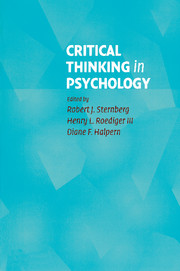Book contents
- Frontmatter
- Contents
- List of Illustrations and Tables
- List of Contributors
- Preface
- 1 The Nature and Nurture of Critical Thinking
- 2 Evaluating Experimental Research
- 3 Critical Thinking in Quasi-Experimentation
- 4 Evaluating Surveys and Questionnaires
- 5 Critical Thinking in Designing and Analyzing Research
- 6 The Case Study Perspective on Psychological Research
- 7 Informal Logical Fallacies
- 8 Designing Studies to Avoid Confounds
- 9 Evaluating Theories
- 10 Not All Experiments Are Created Equal
- 11 Making Claims in Papers and Talks
- 12 Critical Thinking in Clinical Inference
- 13 Evaluating Parapsychological Claims
- 14 Why Would Anyone Do or Believe Such a Thing?
- 15 The Belief Machine
- 16 Critical Thinking and Ethics in Psychology
- 17 Critical Thinking in Psychology
- Author Index
- Subject Index
- References
3 - Critical Thinking in Quasi-Experimentation
Published online by Cambridge University Press: 05 June 2012
- Frontmatter
- Contents
- List of Illustrations and Tables
- List of Contributors
- Preface
- 1 The Nature and Nurture of Critical Thinking
- 2 Evaluating Experimental Research
- 3 Critical Thinking in Quasi-Experimentation
- 4 Evaluating Surveys and Questionnaires
- 5 Critical Thinking in Designing and Analyzing Research
- 6 The Case Study Perspective on Psychological Research
- 7 Informal Logical Fallacies
- 8 Designing Studies to Avoid Confounds
- 9 Evaluating Theories
- 10 Not All Experiments Are Created Equal
- 11 Making Claims in Papers and Talks
- 12 Critical Thinking in Clinical Inference
- 13 Evaluating Parapsychological Claims
- 14 Why Would Anyone Do or Believe Such a Thing?
- 15 The Belief Machine
- 16 Critical Thinking and Ethics in Psychology
- 17 Critical Thinking in Psychology
- Author Index
- Subject Index
- References
Summary
All experiments are about discovering the effects of causes. In this sense, humans always have been experimenters, from early man seeing whether striking a stone against another stone would start a fire, to the modern cook trying out new ingredients in a recipe to see how it changes the taste. All experiments have in common the deliberate manipulation of an assumed cause (striking a stone, adding a new ingredient), followed by observation of the effects that follow (fire, taste). This common thread holds for all modern scientific experiments, including the randomized experiments discussed in the previous chapter, and the quasi-experiments described in the present chapter.
This chapter focuses on critical thinking about causation in quasi-experiments. The reason for this focus on causation is not that other kinds of critical thinking are unimportant in quasi-experiments. To the contrary, every bit of critical thinking that was described in the previous chapter for randomized experiments also has to be done in quasi-experiments, such as choosing good independent and dependent variables, identifying useful populations of participants and settings to study, ensuring that the assumptions of statistical tests are met, and thinking about ways in which the results might generalize. However, the quasi-experimenter also has one more task to do – the critical thinking that takes the place of random assignment.
All tasks in life are easier when you have the proper tools. This chapter describes some of the basic tools we use for the task of critical thinking about causation in quasi-experiments.
- Type
- Chapter
- Information
- Critical Thinking in Psychology , pp. 37 - 53Publisher: Cambridge University PressPrint publication year: 2006
References
- 1
- Cited by



